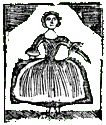Of a Sentimental Nature
In examining the story of Hezekiah Wyman as it first appeared in The Boston Pearl and Literary Gazette, one detail that stands out for me is context. The Pearl was a literary magazine.
The first item in the 22 Aug 1835 issue was “A Love Tale” about a nice woman named Susan Black who finds a husband at age forty. The Wyman story is followed by the third letter in a series from “A Buckeye,” this one headed “Western Poets—Otway Curry.” After a couple of Curry poems the magazine prints a new poem called “The Unforgotten” from a Portsmouth writer signing herself Rebecca.
That content confirms how one bibliographical database has described the Boston Pearl:
A literary miscellany edited by Isaac Pray which pirated a good deal of its material. It published original and selected tales and poems, many of them of a sentimental nature, moral and humorous essays, legends, literary notices, and historical, biographical, and travel sketches. In addition, it contained much miscellaneous material and music for piano.Thus, though the Pearl published “historical” sketches, they were a small part of its content. Its readers expected the magazine’s items to be literary foremost.
And indeed “The White Horseman” doesn’t present Hezekiah Wyman’s story in historical terms. Aside from the credit “By a Soldier of the Revolution,” the text offers no clue about sources or authenticity—no indication that the writer has spoken to witnesses or descendants, no quotations from documents, no explanations of how the writer came to know the story’s details.
Furthermore, the piece is in high literary style, starting in medias res:
The heavy tramp of the regulars, as their solid columns moved amid the darkness toward Concord, was heard with indignation by the waking inhabitants of the country.At first the tale centers on “a large building a few miles below Lexington,” where “The girls assisted their brothers in putting on their equipments, and the old men saddled the horses for his sons.” In comes a local militia officer, “apparently, under thirty years of age; of middling stature, and dark eyes, which now gleamed with fire.” At his entrance, “one young and blooming lass…hung her head, and sighed deeply.”
The officer turns to go. The young woman sighs, “Not one word has he spoken to me.” But then—
Quick as thought, the young Captain sprung to the ground, and giving her a hearty embrace, promised to be with her in a few hours. No answer was returned by the despondent fair one, but she clenched her hands and raised her palid [sic] face to Heaven, as if engaged in inward prayer.—And the lass turns out to be right. According to “The White Horseman,” this officer positions his company in Lexington “behind the village church” to be in position for “harrassing the enemy if they should attempt any damage.” Other companies rush past to join their comrades at Concord, but these Lexington men stand their ground.
There she stood in statue-like silence until the sound of the departing horses’ hoofs had died away. Then turning to her mother, who had remained at her side, she softly said, ‘I shall never see him more!’
Just as the morning dawned, the hasty tramp of men was heard by the little band, and in a moment afterward, the British commander wheeled his steed upon the plain where they stood, and waving his sword, commanded them to throw down their arms and disperse. The Americans were not fast in acknowledging the authority of the epauletted caitiff, and, in an instant, a shower of British balls cut down nearly half of the little company, and put the rest to flight. Captain Roe was among the slain.TOMORROW: Captain Roe?!




